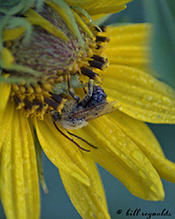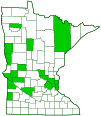Agile longhorn bee
(Melissodes agilis)
Conservation • Description • Habitat • Ecology • Distribution • Taxonomy
Conservation Status |
|||
| IUCN Red List | not listed |
||
| NatureServe | NNR - Unranked SNR - Unranked |
||
| Minnesota | not listed |
||
Description |
Agile longhorn bee is a medium-sized, hairy, ground-nesting bee. It occurs throughout the United States, southern Canada, and northern Mexico. It is found in grasslands, old fields, agricultural fields, and suburban areas. Adults have been recorded in the east as early as May and as late as November. All records from Minnesota are from mid-July to late September. Agile longhorn bees apparently specialize in collecting pollen exclusively from sunflower plants. Females are 7⁄16″ to ⅝″ (10.5 to 15.0 mm) in length. The body is robust and almost entirely black. The head is as wide as the thorax and is densely covered with long, more or less erect, pale brownish-yellow or orangish hairs. The plate on the face (clypeus) is entirely black, is not lobed, and sticks out very slightly. Near the inner margin of each compound eye there is a row of stiff hairs that stick straight up. The top of the head is flat, not rounded, causing the simple eyes (ocelli) to bulge out. There is an obscure yellowish spot at the end of the jaws (mandibles). The antennae are black above, brownish yellow on the underside. They have 12 segments, a long scape at the base, a short pedicel, and a whip-like section (flagellum) with 10 segments (flagellomeres). The first flagellomere is less than half as long as the second. The thorax is densely covered with long, more or less erect, pale brownish-yellow or orangish hairs. The small plate on each side above the base of the wing (tegula) is tapered on one side, giving it a tear-drop shape. This is a defining feature of the genus Melissodes, but it is hidden beneath long hairs and cannot be seen without scraping the hairs away. The first abdominal segment (tergite) is covered with abundant, rather long, pale hairs. Tergites 2 through 4 have a yellowish band at the base. Tergite 5 is covered with long black hairs but has some long brownish-yellow hairs on each side. The legs are black and hairy. The pollen-collecting hairs (scopa) on the fourth segment (tibia) of the hind leg are yellowish or orangish and are densely feather-like (plumose). The wings are clear. The veins are blackish brown to black |
Size |
Female total length: 7⁄16″ to ⅝″ (10.5 to 15.0 mm) Male total length: ⅜″ to ½″ (9 to 12 mm) |
Similar Species |
Habitat |
Grasslands, old fields, agricultural fields, and suburban areas |
Ecology |
Season |
Mid-July to late September in Minnesota |
Behavior |
|
Life Cycle |
|
Food |
Nectar and pollen, mostly from sunflowers |
Distribution |
||
|
Sources Biodiversity occurrence data published by: Minnesota Biodiversity Atlas (accessed through the Minnesota Biodiversity Atlas Portal, bellatlas.umn.edu, 9/5/2025). |
|
| 9/5/2025 | ||
Occurrence |
||
|
||
Taxonomy |
|
Order |
Hymenoptera (Ants, Bees, Wasps, and Sawflies) |
Suborder |
Apocrita (Narrow-waisted Wasps, Ants, and Bees) |
Infraorder |
Aculeata (Ants, Bees, and Stinging Wasps) |
Superfamily |
Apoidea (Bees and Apoid Wasps) |
Epifamily |
|
Family |
Apidae (honey bees, bumble bees, and allies) |
Subfamily |
Apinae (honey, bumble, longhorn, orchid, and digger bees) |
Tribe |
Eucerini (longhorn bees) |
Genus |
|
Subgenus |
|
Subordinate Taxa |
|
|
|
Synonyms |
|
Melissodes aurigenia Melissodes pennsylvanica Melissodes philadelphica |
|
Common Names |
|
agile longhorn bee agile long-horned bee |
|
Glossary
Clypeus
On insects, a hardened plate on the face above the upper lip (labrum).
Flagellomere
A segment of the whip-like third section of an insect antenna (flagellum).
Ocellus
Simple eye; an eye with a single lens. Plural: ocelli.
Pedicel
On plants: the stalk of a single flower in a cluster of flowers. On insects: the second segment of the antennae. On Hymenoptera and Araneae: the narrow stalk connecting the thorax to the abdomen: the preferred term is petiole.
Plumose
Feathery; having fine, pinnately arranged, lateral bristles or hairs arranged on both sides of an axis.
Scape
In plants: An erect, leafless stalk growing from the rootstock and supporting a flower or a flower cluster. In insects: The basal segment of the antenna.
Scopa
A brush-like tuft of hairs on the legs or underside of the abdomen of a bee used to collect pollen.
Tergite
The upper (dorsal), hardened plate on a segment of the thorax or abdomen of an arthropod or myriapod.
Tibia
The fourth segment of an insect leg, after the femur and before the tarsus (foot). The fifth segment of a spider leg or palp. Plural: tibiae.
Visitor Photos
Share your photo of this insect.
This button not working for you?
Simply email us at info@MinnesotaSeasons.com.
Attach one or more photos and, if you like, a caption.
Bill Reynolds |
||
Long-horned bee |
||
 |
 |
|
Two Long-horned bees on a Maximilian Sunflower |
||
|
||
|
||
|
… just a single bee on the Maximilian |
|
MinnesotaSeasons.com Photos
|

Slideshows
Melissodes trinodis
Sam Droege

Visitor Videos
Share your video of this insect.
This button not working for you?
Simply email us at info@MinnesotaSeasons.com.
Attach a video, a YouTube link, or a cloud storage link.
Other Videos
Flight of the Melissodes agilis
Kathy Keatley Garvey
Squash Bee Peponapis & Sunflower Bee Melissodes agilis in Ontario. Part 1. Пчелы опылители
tatromain
Squash Bee Peponapis & Sunflower Bee Melissodes agilis in Ontario. Part 2. Пчелы опылители . Ч.2.
Author



